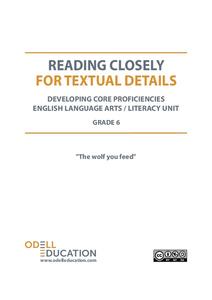This Reading Closely for Textual Details: Grade 6 unit plan also includes:
- Reading Closely Grade 6 Unit Texts (.pdf)
- Guiding Questions Handout (.pdf)
- Reading Closely Checklist (.pdf)
- Text-Centered Discussions Checklist (.pdf)
- Questioning Texts - Hutt (.pdf)
- Analyzing Details - Hutt (.pdf)
- Questioning Text (.pdf)
- Analyzing Details (.pdf)
- Program Guide (.pdf)
- Join to access all included materials
Close reading doesn't mean to literally read text close to your face, but rather to pay attention to particular details in order to develop a deep and purposeful understanding of text. The first part of a five-part resource provides an introduction of close reading to pupils through discussion of elements and guided analysis activities. The focus of the second part is questioning text; pupils use guiding questions to analyze informational text before creating their own questions in order to analyze text deeply. During the third part, learners are guided through the analysis of details in multiple text types, and realize and are able to explain meaning by listening, reading, and writing. The fourth part serves as a culminating lesson in which they learn to summarize their findings about close reading strategies from the previous lessons. Class members then participate in grand text-centered discussions with other learners during the fifth lesson.
Concepts
Additional Tags
Instructional Ideas
- Assign the worksheets as an online homework assignment, as the reproducibles have fields for typing
- Tailor the unit plan to meet the needs of all learners and time constraints presented in the classroom
Classroom Considerations
- The first in a series of four units designed to meet Common Core based literacy proficiencies; each unit can be used individually or collectively
- The first eight pages give background knowledge, explains the support the unit provides, ways to use the resource, and benefits of close reading
- Refer to the unit outline and texts for quick reference
- Text-level difficulty progresses as the lessons build on one another
Pros
- The 37-page packet includes background information for the teacher, step-by-step plans, guided questions, checklists, worksheets and models of sheets, and assessment opportunities
- Each lesson in the unit is aligned to meet specific Common Core standards
- Lessons are easily adaptable to other texts
Cons
- None



